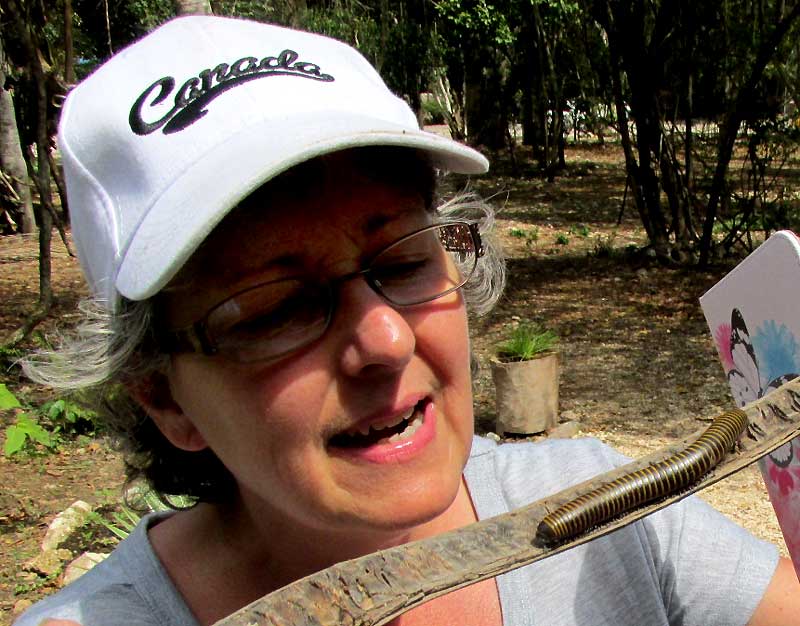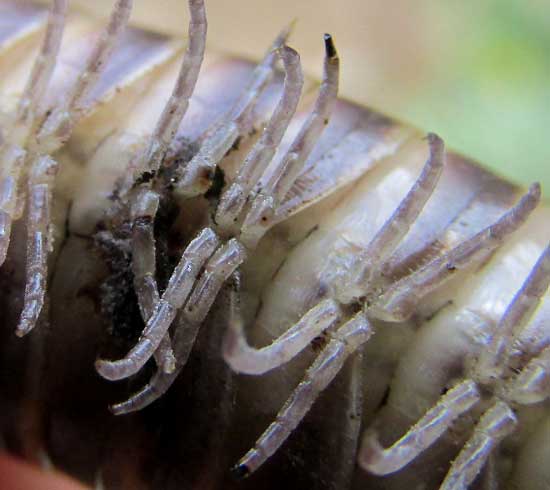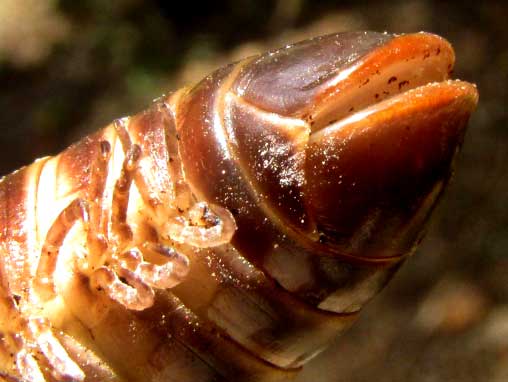Excerpts from Jim Conrad's
Naturalist Newsletter
from the February 28, 2016 Newsletter issued from Hacienda Chichen Resort beside Chichén Itzá Ruins, central Yucatán MÉXICO

CHICHÉN ITZÁ BUMBLEBEE MILLIPEDE
Right before leaving for home in Ontario, Bea appeared at the hut door big-eyed and smiling, carrying on a Royal Poinciana pod the biggest millipede she'd ever seen, that moment of discovery shown above.
Of course this wasn't an insect, which usually is Bea's domain, because insects have six legs while millipedes have many. Below, you can see several of those legs in a head shot of the millipede:

Also, it was a millipede and not a centipede because each segment of a centipede's body bears a single pair of legs, two legs, while each segment of a millipede's body bears two pairs, or four legs, as displayed below:

Besides its size and shape, this millipede struck me as having a distinctive anus, so I took a picture of that, too, shown below:

At first I thought I'd easily identified the critter because simply by doing a Google image search on the key words "millipede tropical large black yellow" many thumbnail pictures turned up showing what looked like Bea's discovery. They were labeled Anadenobolus monilicornis, often known as Bumblebee Millipedes, distributed in the Caribbean area and currently invading southern Florida. Many other kinds of Caribbean species also turn up in the Yucatan, so maybe Bumblebee Millipedes do, too.
However, Rowland Shelley's 2014 article in Insecta Munda, discussing Anadenobolus monilicornis, includes drawings of the millipede's parts. Some of the features were slightly different from Bea's millipede. In lists of species of the genus Anadenobolus I found mention of Anadenobolus chichen, collected here at Chichén Itzá ruins, but I can't find literature or illustrations portraying Anadenobolus chichen, so I don't know for sure that that's what we have.
According to Shelley's detailed map of the Caribbean millipede's distribution, we're a good bit outside where that species is to be expected. The only mention I can find of a millipede looking like Bea's found in our area is Anadenobolus chichen. Therefore, here I'm filing our information and picture under ANADENOBOLUS CHICHEN, and so far it looks like our pictures of Bea's millipede may be the only illustrations available for that narrowly endemic species.
So, how's that for an amateur bug-identifier finding something that even the experts would be tickled to see, and finding something that truly may be scientifically significant?
By the way, if someone has access to scientific literature, Anadenobolus chichen was first described as Rhinocricus chichen in American Midland Naturalist, 50:145," 1953. Maybe there's info there that can help firm up this ID.
from the November 19, 2017 Newsletter issued from Rancho Regenesis in the woods ±4kms west of Ek Balam Ruins; elevation ~40m (~130 ft), N20.876°, W88.170°; north-central Yucatán, MÉXICO
ESTIVATING MILLIPEDE
In our area, in mid November, if you dig into garden soil still moist from the recently ended rainy season, you may very likely see what's shown below:

That millipede was disturbed several inches below the soil's surface, tightly coiled in the chamber from which one of his ends emerges.
While digging a bed for this dry season's chard crop I encountered four or five such millipede-occupied chambers. I'm assuming that the species has moved into the soil while it's still moist and soft enough to burrow through, and in its subterranean chamber will "estivate" until rains return next June or so.
The New Oxford American Dictionary installed on my Kindle defines estivation as "Prolonged torpor or dormancy of an animal during a hot or dry period."